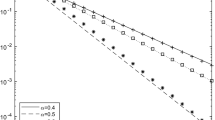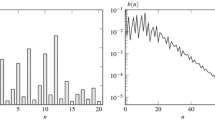Abstract
Methods are developed for approximately characterizing the departure process of each customer class from a multi-class single-server queue with unlimited waiting space and the first-in-first-out service discipline. The model is σ(GT i /GI i )/1 with a non-Poisson renewal arrival process and a non-exponential service-time distribution for each class. The methods provide a basis for improving parametric-decomposition approximations for analyzing non-Markov open queueing networks with multiple classes. For example, parametric-decomposition approximations are used in the Queueing Network Analyzer (QNA). The specific approximations here extend ones developed by Bitran and Tirupati [5]. For example, the effect of class-dependent service times is considered here. With all procedures proposed here, the approximate variability parameter of the departure process of each class is a linear function of the variability parameters of the arrival processes of all the classes served at that queue, thus ensuring that the final arrival variability parameters in a general open network can be calculated by solving a system of linear equations.
Similar content being viewed by others
References
S.L. Albin, Approximating a point process by a renewal process, II: Superposition arrival processes to queues, Oper. Res. 32 (1984) 1133–1162.
S.L. Albin, Delays for customers from different arrival streams to a queue, Manag. Sci. 32 (1986) 329–340.
S.L. Albin and S. Kai, Approximation for the departure process of a queue in a network, Nav. Res. Log. Qtrly. 33 (1986) 129–143.
P. Billingsley,Convergence of Probability Measures (Wiley, New York, 1968).
G.R. Bitran and D. Tirupati, Multiproduct queueing networks with deterministic routing: Decomposition approach and the notion of interference, Manag. Sci. 34 (1988) 75–100.
J.A. Buzacott and J.G. Shanthikumar, On approximate queueing models of dynamic job shops, Manag. Sci. 31 (1985) 347–366.
K.M. Chandy and C.H. Sauer, Approximate methods for analyzing queueing network models of computer systems, Comp. Surveys 10 (1978) 281–317.
J.G. Dai, V. Nguyen and M.I. Reiman, Sequential bottleneck decomposition: An approximation method for open queueing networks, Oper. Res., to appear.
K.W. Fendick, V.R. Saksena and W. Whitt, Dependence in packet queues, IEEE Trans. Commun. COM-37 (1989) 1173–1183.
K.W. Fendick, V.R. Saksena and W. Whitt, Investigating dependence in packet queues with the index of dispersion for work, IEEE Trans. Commun. COM-39 (1991) 1231–1244.
W. Fischer and D. Stanford, Approximations for the per-class waiting time and interdeparture time in the σ i GI i /GI i /1 queue, Siemens, München (1989).
E. Gelenbe and I. Mitrani,Analysis and Synthesis of Computer Systems (Academic Press, New York, 1980).
J.M. Harrison and V. Nguyen, The QNET method for two-moment analysis of open queueing networks, Queueing Syst. 6 (1990) 1–32.
J.M. Harrison and V. Nguyen, Brownian models of multiclass queueing networks: Current status and open problems, Queueing Syst. 13 (1993) 5–40.
J.M. Holtzman, Mean delays of individual streams into a queue: The σG i /M/1 queue,Applied Probability-Computer Science: The Interface, eds. R.L. Disney and T.J. Ott (Birkhäuser, Boston, 1982) pp. 417–430.
D.L. Iglehart and W. Whitt, Multiple channel queues in heavy traffic, I, Adv. Appl. Prob. 2 (1970) 150–177.
D.L. Iglehart and W. Whitt, Multiple channel queues in heavy traffic, II: Sequences, networks and batches, Adv. Appl. Prob. 2 (1970) 355–369.
L. Kleinrock,Communication Nets (McGraw-Hill, New York, 1964).
W. Kraemer and M. Langenbach-Belz, Approximate formulae for the delay in the queueing systemGI/G/1,Proc. 8th Int. Teletraffic Congress, Melbourne (1976).
P.J. Kuehn, Approximate analysis of general queueing networks by decomposition, IEEE Trans. Commun. COM-27 (1979) 113–126.
B. Pourbabai and D. Sonderman, Approximation of departure process from aG/M/1/0 queueing system, Oper. Res. Lett. 4 (1986) 201–205.
M.I. Reiman, Asymptotically exact decomposition approximations for open queueing networks, Oper. Res. Lett. 9 (1990) 363–370.
M. Reiser and H. Kobayashi, Accuracy of the diffusion approximation for some queueing systems, IBM J. Res. Dev. 18 (1974) 110–124.
M. Segal and W. Whitt, A queueing network analyser for manufacturing,Teletraffic Science for New Cost-Effective Systems, Networks and Services, ITC-12, ed. M. Bonatti (Elsevier Science, Amsterdam, 1989) pp. 1146–1152.
K.C. Sevcik, A.I. Levy, S.K. Tripathi and J.L. Zahorjan, Improving approximations of aggregated queueing network subsystems,Computer Performance, eds. K.M. Chandy and M. Reiser (North-Holland, Amsterdam, 1977) pp. 1–22.
J.G. Shanthikumar and J.A. Buzacott, Open queueing network models of dynamic job shops, Int. J. Prod. Res. 19 (1981) 255–266.
D.A. Stanford and W. Fischer, The interdeparture-time distribution for each class in the σM i /G i /1 queue, Queueing Syst. 4 (1989) 177–190.
D.A. Stanford and W. Fischer, Characterizing interdeparture times for bursty input streams in the queue with pooled renewal arrivals, Stoch. Mod. 7 (1991) 311–320.
S. Suresh and W. Whitt, The heavy-traffic bottleneck phenomenon in open queueing networks, Oper. Res. Lett. 9 (1990) 355–362.
W. Whitt, Some useful functions for functional limit theorems, Math. Oper. Res. 5 (1980) 67–85.
W. Whitt, Approximating a point process by a renewal process, I: Two basic methods, Oper. Res. 30 (1982) 125–147.
W. Whitt, The queueing network analyzer, Bell Syst. Tech. J. 62 (1983) 2779–2815.
W. Whitt, Approximations for departure processes and queues in series, Nav. Res. Log. Qtrly. 31 (1984) 499–521.
W. Whitt, Approximations for theGI/G/m queue, AT & T Bell Laboratories, Murray Hill, NJ (1985).
W. Whitt, Approximations for single-class departure processes from multi-class queues, AT&T Bell Laboratories, Murray Hill, NJ (1987).
W. Whitt, A light-traffic approximation for single-class departure processes from multi-class queues, Manage. Sci. 34 (1988) 1333–1346.
W. Whitt, Large fluctuations in a deterministic multiclass network of queues, Manag. Sci. 39 (1993), to appear.
Author information
Authors and Affiliations
Rights and permissions
About this article
Cite this article
Whitt, W. Towards better multi-class parametric-decomposition approximations for open queueing networks. Ann Oper Res 48, 221–248 (1994). https://doi.org/10.1007/BF02024659
Issue Date:
DOI: https://doi.org/10.1007/BF02024659




